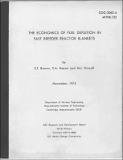The economics of fuel depletion in fast breeder reactor blankets
Author(s)
Brewer, Shelby Templeton
Download856905055.pdf (15.74Mb)
Other Contributors
Massachusetts Institute of Technology. Department of Nuclear Engineering
United States. Department of Energy
U.S. Atomic Energy Commission
Metadata
Show full item recordAbstract
A fast breeder reactor fuel depletion-economics model was developed and applied to a number of 1000 MWe UMBR case studies, involving radial blanket-radial reflector design, radial blanket fuel management, and sensitivity of energy costs to changes in the economic environment. Choice of fuel cost accounting philosophy, e.g. whether or not to tax plutonium revenue, was found to have significant effect on absolute values of energy costs, without, however, distorting design rankings, comparative results, and irradiation time optimization. A single multigroup physics computation, to obtain the flux shape and local spectra for depletion calculations, was found to be sufficient for preliminary design and sensitivity studies. The major source of error in blanket depletion results was found to be the assumption of a fixed flux snape over an irradiation cycle; spectrum hardening in the radial blanket with irradiation is of minor importance. The simple depletion-economics model was applied to several 1000 NWe L1FBR case studies. Advantages of a moderating reflector were found to increase as blanket thickness was reduced. For a 45 cm radial blanket, a beryllium metal reflector offered little improvement, in blanket fuel economics, over sodium; for a 15 cm blanket, beryllium increased net blanket revenue by about 60%. An improvement of about 30% in net blanket revenue resulted when each radial blanket annular region was assumed to be expose" to its own local optimum irradiation time. Optimum radial blanket irradiation time and the net blanket revenue (mills/Khiie) at this optimum were found to be approximately linear in the unit fuel cycle costs, i.e. fabrication and reprocessing costs ($/4gld) and fissile market value ($/kg).
Description
"November, 1972." Also issued as a Ph. D. thesis by the first author and supervised by the second and third author, MIT, Dept. of Nuclear Engineering 1973 Includes bibliographical references (pages 333-342)
Date issued
1972Publisher
Cambridge, Mass. : Massachusetts Institute of Technology, Dept. of Nuclear Engineering, [1972]
Series/Report no.
MITNE ; no. 123COO (Series) ; 3060-4AEC research and development report